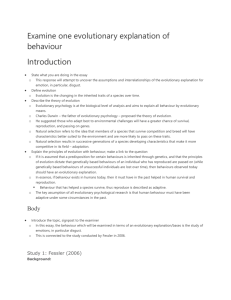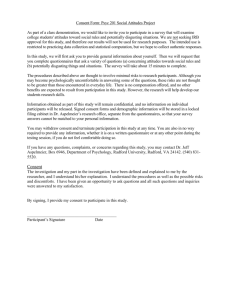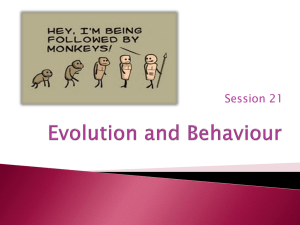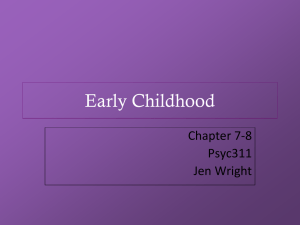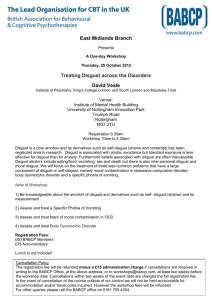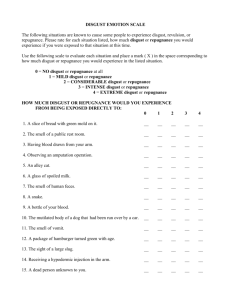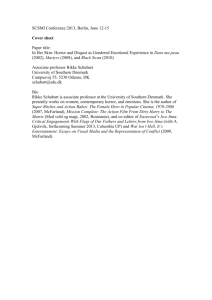individual differences in sensitivity to disgust
advertisement
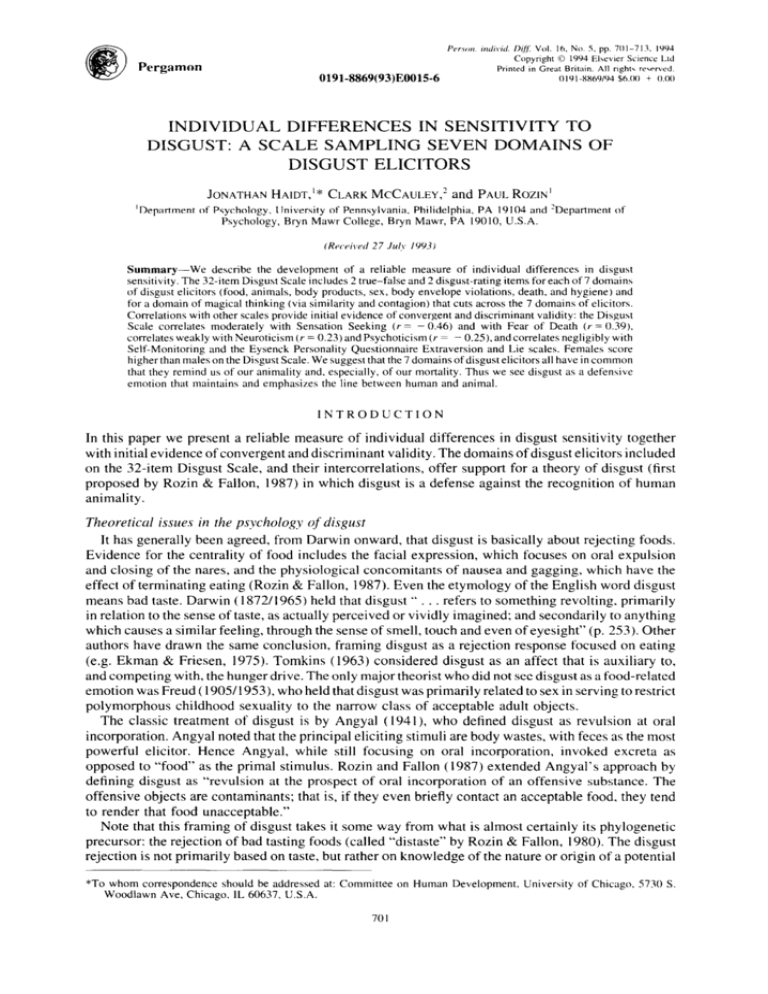
Prrwm ~mlrkl. /Xfi: Vol. Copyrlpht Pergamon Printed in Great 0191~8869(93)30015-6 16, No 0 5. pp. 7111-713. 1994 El\cwer Britain. All 0 I Y I -XXhY/Y4 IYY4 Sc~rnce right\ $6.(W) Ltd reerved. t 0.00 INDIVIDUAL DIFFERENCES IN SENSITIVITY TO DISGUST: A SCALE SAMPLING SEVEN DOMAINS OF DISGUST ELICITORS JONATHAN HAIDT,‘* ‘Department CLARK MCCAULEY,’ and PAUL ROZIN’ of Psychology, University of Pennsylvania, Philidelphia, PA 19104 and ‘Department Psychology. Bryn Mawr College, Bryn Mawr, PA 19010, U.S.A. (Rucriwd of 27 Julv 1YY3) Summary-We describe the development of a reliable measure of individual differences in disgust sensitivity. The 32-item Disgust Scale includes 2 true-false and 2 disgust-rating items for each of 7 domains of disgust elicitors (food, animals, body products, sex, body envelope violations, death. and hygiene) and for a domain of magical thinking (via similarity and contagion) that cuts across the 7 domains of elicitors. Correlations with other scales provide initial evidence of convergent and discriminant validity: the Disgust Scale correlates moderately with Sensation Seeking (r = - 0.46) and with Fear of Death (u = 0.39). correlates weakly with Neuroticism (r = 0.23) and Psychoticism (r = - 0,25),andcorrelates negligibly with Self-Monitoring and the Eysenck Personality Questionnaire Extraversion and Lie scales. Females score higher than males on the Disgust Scale. We suggest that the 7 domains of disgust elicitors all have in common that they remind us of our animality and. especially, of our mortality. Thus we see disgust as a defensive emotion that maintains and emphasizes the line between human and animal. INTRODUCTION In this paper we present a reliable measure of individual differences in disgust sensitivity together with initial evidence of convergent and discriminant validity. The domains of disgust elicitors included on the 32-item Disgust Scale, and their intercorrelations, offer support for a theory of disgust (first proposed by Rozin & Fallon, 1987) in which disgust is a defense against the recognition of human animality. Theoretical issues in the psychology of disgust It has generally been agreed, from Darwin onward, that disgust is basically about rejecting foods. Evidence for the centrality of food includes the facial expression, which focuses on oral expulsion and closing of the nares, and the physiological concomitants of nausea and gagging, which have the effect of terminating eating (Rozin & Fallon, 1987). Even the etymology of the English word disgust means bad taste. Darwin ( 187211965) held that disgust *‘ . . refers to something revolting, primarily in relation to the sense of taste, as actually perceived or vividly imagined: and secondarily to anything which causes a similar feeling, through the sense of smell, touch and even of eyesight” (p. 253). Other authors have drawn the same conclusion, framing disgust as a rejection response focused on eating (e.g. Ekman & Friesen, 1975). Tomkins (1963) considered disgust as an affect that is auxiliary to, and competing with, the hunger drive. The only major theorist who did not see disgust as a food-related emotion was Freud (1905/1953), who held that disgust was primarily related to sex in serving to restrict polymorphous childhood sexuality to the narrow class of acceptable adult objects. The classic treatment of disgust is by Angyal ( 1941), who defined disgust as revulsion at oral incorporation. Angyal noted that the principal eliciting stimuli are body wastes, with feces as the most powerful elicitor. Hence Angyal, while still focusing on oral incorporation, invoked excreta as opposed to “food’ as the primal stimulus. Rozin and Fallon (1987) extended Angyal’s approach by defining disgust as “revulsion at the prospect of oral incorporation of an offensive substance. The offensive objects are contaminants; that is, if they even briefly contact an acceptable food, they tend to render that food unacceptable.” Note that this framing of disgust takes it some way from what is almost certainly its phylogenetic precursor: the rejection of bad tasting foods (called “distaste” by Rozin & Fallon, 1980). The disgust rejection is not primarily based on taste, but rather on knowledge of the nature or origin of a potential *To whom correspondence should be addressed Woodlawn Ave. Chicago. IL 60637, U.S.A. at: Committee 701 on Human Development, University of Chicago, 5730 S. 702 JONATHAN HNIIT et d. food. Things that taste bad do not necessarily have the property of contamination. For example, dipping a disliked vegetable in and out of a bowl of soup would not render the soup undrinkable for most people. Dipping a sterilized cockroach into the soup generally has a more dramatic effect. Disgust rejections have been shown to follow two laws of sympathetic magic, which were first proposed by Tylor ( 187 I /1974), Frazer ( 1890/l 959), and Mauss ( 1902/l 972). The law of contagion, “once in contact, always in contact,” refers to the tendency to act as if brief contact causes a permanent transfer of properties from one object to another, even when there is no material substance transferred. Some people, for example, report that they would not drink from a glass that once held dog feces no matter how many times the glass is scrubbed and sterilized (Rozin, Millman & Nemeroff, 1986; Rozin & Nemeroff. 1990). The second law, the law of similarity, holds that “the image equals the object.” For example, a piece of chocolate fudge becomes far less desirable when it is shaped like a piece of dog feces (Rozin et al., 1986). This brief review leads to the conclusion that disgust is, at its core, an oral defense. Disgust acts as a kind of guardian of the mouth, protecting against the oral incorporation of offensive or contaminated foods, where the principal contaminants to be avoided are the waste products of human or animal bodies. Yet in our American Ss, and in the other cultures we have examined, the revulsion associated with disgust extends far beyond this food-related core. Gore and dismemberment of the human body often elicits disgust, as does a range of sexual acts, especially incest. When we began our research it was not clear to us how many domains of disgust elicitors there were, nor did we know the extent to which individual differences in disgust sensitivity might be domain-specific. There is currently no good measure of disgust sensitivity. Rozin, Fallon and Mandell (1984) developed a scale to measure concerns about food contamination (e.g. reluctance to drink soup stirred by a thoroughly washed flyswatter), and found substantial correlations among parents and their children. Davey, Forster and Mayhew (1993) used the same scale, and replicated the finding of significant parent-child correlation. This scale is not suitable as a genera1 disgust scale however, because it deals with only one kind of disgust elicitor-food contamination. Similarly, Templer, King, Brooner and Corgiat (1984) developed a scale to measure attitudes about body products and body elimination (e.g. “the smell of other persons’ bowel movements bother me”). This scale is also limited to one kind of disgust elicitor, and it was developed on a relatively small S pool (N = 92). However Templer ef crl. found a number of demographic correlates of their scale that will be of interest in our results. They found that women and younger people showed stronger negative attitudes towards body products, and they found a relationship between strong negative attitudes and anxiety-based psychopathology. High scorers on their scale also scored high on measures of neuroticism, obsessiveness, and psychasthenia. Our first goal in scale development was to ascertain the kinds or domains of experience in which Americans experience disgust. That is, what should a disgust scale ask about? Earlier theorists, cited above, have pointed to issues surrounding food, body products, and sex. Rather than limiting our scale to these three domains, however, we chose to begin in a more empirical fashion by asking an ad hoc pane1 of informants about what they found disgusting. We asked 15 students and 5 secretaries at the University of Pennsylvania to describe the three most disgusting experiences of their lives, and then to list as many disgusting things as they could think of. This open-ended inquiry yielded a total of 22 1 descriptions of disgusting objects and actions. Foods, body products, and sexuality were indeed well represented, accounting for 57% of all descriptions. There were, however, 5 additional domains of disgust suggested. The largest of these domains (13% of all descriptions) involved gore, surgery, puncture wounds, deformity, and other situations in which the normal exterior envelope of the body is breached or altered. We refer to this fourth domain as “envelope violations.” The fifth domain (6% of descriptions) involved repulsive people whose actions were not necessarily linked to the physical body, as was characteristic of the first 5 domains. We refer to this domain as “socio-moral violations,” and it included, for example, Nazis, drunk drivers, hypocrites, and lawyers who chase ambulances. The sixth domain (6% of descriptions) referred to disgusting animals, mostly insects. The seventh domain (4%) involved concerns about dirt and germs (“hygiene”). The eighth domain was very small ( 1%). involving contact with dead human or animal bodies (“death”). Thirteen percent of responses were uncodable without additional information (e.g. “genetic engineering”). Disgust 703 These 8 domains (food, sex, body products, envelope violations, socio-moral violations, animals, hygiene and death) served as heuristics in the representation of a broad range of disgust elicitors in our scale. We recognized that other divisions of the open-ended descriptions would have been possible, and we did not assume the psychological distinctiveness of these 8 domains. Rather we left the status of these domains as an empirical question to be addressed in the course of item analysis. Toward this end, we tried to write some items to represent each domain separately. We encountered some difficulties here, as many of the items drawn from the open-ended descriptions implicated multiple domains. In the end, we included items that tapped more than one domain (multiple-domain items) and items that represented, as best we could, only one domain (domain-specific items). Another issue for scale development concerned the format of the questions to be written. Individuals may differ significantly in their use of the term “disgust”, just as they differ in their understanding of the meaning of trait words such as intelligent or dominant (Beck, McCauley, Segal & Hershey, 1988). For instance, some individuals might call socio-moral violators (e.g. Nazis) disgusting whereas others, no less negative toward such violators, might not extend the term so far from the domains of the body. We did not want individual differences in use of the word “disgusting” to be confounded with differences in sensitivity to a particular disgust elicitor. Thus we could not depend entirely on questions asking respondents to rate how disgusting they found a particular situation or experience. This concern led us to write items in two different formats, appearing on two separate pages of our initial questionnaire. The first page presented 54 “true/false” questions about persona1 reactions and behaviors that were described without any reference to disgust. These questions were drawn from all 8 of the domains identified above, and were intended to probe actual avoidance behaviors (“I avoid touching doorknobs in public places”) as well as affective reactions to potential disgust elicitors (“I find some body odors sexually stimulating”-reverse scored). The second page presented respondents with descriptions of 53 potentially disgusting situations, again drawn from all eight domains. Respondents were asked to rate each description on a 3 point scale of “not disgusting at all”, “slightly disgusting”, or “very disgusting”. This initial questionnaire was given to 54 undergraduates at the University of Pennsylvania. For each respondent, a total score was calculated as the sum of the Personal Reactions subtotal (number of disgust-sensitive responses) and the Disgust Rating subtotal (sum of disgust-ratings). Items with low item-total correlations were eliminated, as were items for which more than 90% of the respondents gave the same response. Seventy eight items were retained. An additional 58 items were then written to obtain approximately equal numbers of domain-specific items for each of the 8 domains, in both the true-false and disgust-rating formats. This second questionnaire ( I36 items) was given to 126 undergraduates at the University of Pennsylvania, and to 37 employees of the U.S. Department of Labor in Washington DC. Again, items that did not correlate with total score were dropped, as were domain-specific items that showed low item-domain correlations and items that showed low variance. Sixty six items were retained for the Preliminary Disgust Questionnaire. Results of these preliminary studies presented two surprises. First, we found that the socio-moral items (e.g. stealing from a blind beggar) did not reliably correlate with total score. The only moral items that did correlate reliably with total score were those that dealt with sexuality (e.g. questions about the morality of homosexuality, incest, bestiality). These results led us to combine the sexual morality items with sexual behavior items in a domain now called simply “sex”, and to drop the socio-moral domain. The second surprise was that items about contact with death produced some of the highest correlations with total score. We had expected items representing the death domain to be only marginally useful, because this was one of the smallest domains in the open-ended disgust descriptions, and because the scholarly literature has said little about a link between disgust and death. The success of death items in our preliminary studies led us to include a measure of fear of death in one of the main studies to be reported below. In addition to these two surprises, the preliminary studies offered some reassurance. The correlation of the two subscales, based on true-false items and disgust-rating items, was substantial (TS of 0.60-0.70). The patterns of item correlations suggested that, although item format did control some variance, this variance was relatively small. We determined to continue with both formats in order to make possible a reliability estimate for total score that could include generalization across format. 704 Joh.\lH,\~ H:\II)I <‘I I//. Thus the product of our preliminary studies was a 66-item Preliminary Disgust Questionnaire with items representing 7 domains of disgust elicitors: food. animals, body products, sex. body envelope violations, death, and hygiene. For each domain we included 2 to 5 domain-specific items in each of the 2 item formats. We also included a number of items that spanned multiple domains, and that showed high correlations with total score in the preliminary studies. There were 37 true-false items on page one and 29 disgust-rating items on page two. About one third of the true-false items were reverse scored. This 66-item Preliminary Disgust Questionnaire was further refined to a 32-item Disgust Scale on the basis of the research reported below. METHOD Four samples, including student and non-student respondents. contributed to selection of a 32-item Disgust Scale and to an assessment of the reliability and homogeneity ofthis scale across the 7 domains identified above. One of the samples also provided evidence about the relation between the Disgust Scale and 7 personality scales relevant to convergent and discriminant validity. We think of disgust as a defensive emotion, guarding the purity of the body, and perhaps of the self or soul residing within the body. As mentioned above, Templer et 01. ( 1984). found a relationship between anxiety and attitudes toward body elimination. We therefore predicted that more disgust sensitive respondents would score higher on the Eysenck Personality Questionnaire (EPQ) Neuroticism Scale, where individuals with high scores are described as “anxious and worrying reacting too strongly to all sorts of stimuli” (Eysenck & Eysenck, 1975). Another convergent validity prediction stems from our finding in the preliminary studies that items about death were very good predictors of disgust sensitivity. Rosin and Fallon (1987) suggested that disgust serves to emphasize the distinction between humans and animals, and mortality is a powerful threat to that distinction (Becker, 197.3). People with greater fear of death may have a greater need to employ the defensive emotion of disgust. in order to emphasize the line between humanity and animality. Scores on the Disgust Scale should therefore correlate with scores on the Fear of Death Scale (Boyer, 1964). an I X-item scale measurin g concerns about various aspects of death and dying. Finally, if disgust is a defensive emotion. guarding the purity of body and soul, then disgust sensitivity should be inversely related to sensation seekin, (7 (Zuckerman. 1979). Disgllst sensitive people should be wary of new foods, sexual activities. drugs, or any other unusual experience that puts the temple of the body at risk, either of death or defilement. We predicted that disgust sensitivity would correlate negatively with the Experience Seeking subscale (measuring desires for new experiences through the mind and senses) and negatively with the Thrill and Adventure Seeking subscale (measuring desire to engage in excitin g but dangerous physical activities) of Zuckerman’s (1979) Sensation Seeking Scale, form V. The correlations predicted thus far are part of a strategy of convergent validation. In contrast. discriminant validation calls for predictions of weak and non-signifcant correlations between the Disgust Scale and measures representin g constructs other than a specific sensitivity to disgust. One possibility is that the Disgust Scale measures only a general tendency to respond to events emotionally. To control for this possibility, a 4-item emotionality subscale was embedded within the 66 disgust items of the preliminary questionnaire, in which Ss were asked (true or false) whether they were more fearful, emotional, easily angered, or easily embarrassed than most people. If the disgust scale measures something more specific than general emotionality, then self-reports of emotionality should show at most weak correlations with disgust sensitivity. A second possibility is that the Disgust Scale measures self-presentational concerns. and respondents’ answers reflect how they want to be perceived by themselves or others. This possibility seemed especially plausible because the preliminary disgust scale included a number of personally revealing questions (e.g. “I would enjoy performing oral sex on someone I loved”). To provide discriminant validity on this point, we predicted that the Disgust Scale would not correlate with two scales assessing self-presentational concerns: the Self-Monitor-in g Scale (Snyder, 1974) and the Lie scale of the EPQ (Eysenck & Eysenck, 1975). In addition to these specific discriminant validity predictions. we saw no reason to expect correlation 705 Disgust between the Disgust Scale and either the Psychoticism or Extraversion Scales of the EPQ, or between the Disgust Scale and the Disinhibition subscale (measuring desires for disinhibition and excitement in the social sphere) or the Boredom Susceptibility subscale (measuring an aversion for repetition or routine of any kind) of Zuckerman’s (1979) Sensation Seeking Scale. Intermingled with the 66 disgust items, we included 9 additional items designed to assist in quality control and validation. Four “catch” questions were included which were written to elicit a predictable response from any respondent paying attention (e.g.fulse for “I never touch money with my bare hands”). Also included was the 4-item emotionality scale already described. And finally, there was a s.ingle true-false item asking the respondent directly whether he or she is more sensitive to disgust than most people. We predicted a significant positive correlation between this item and the Disgust Scale. Respondents Four samples of respondents completed the Preliminary Disgust Questionnaire. The College1 sa,mple was composed of 182 students in a social psychology class at the University of Pennsylvania who volunteered to complete the Disgust Questionnaire (83% of total class, 61% female, mean age 19). The College2 sample was 126 psychology students at the University of Pennsylvania who were fulfilling a research participation requirement (54% female, mean age 19). The PhysPlant sample was 170 physical plant workers at the University of Pennsylvania (36% female, mean age 40, mean years of education 12.2), covering a range of blue-collar occupations. The FuodPvofsample was 46 people (40% female, mean age 36, mean years of education 15.5) out of approx. 55 people attending a conference of food processing professionals. In terms of social class, the two college samples can be described as predominantly upper-middle class, the PhysPlant sample as lower-middle or working class, and the FoodProf sample as middle class. Both college samples were approx. 80% White, 15% Asian, and 5% Black. The FoodProf sample was 93% White, 5% Black, and 2% Asian. The PhysPlant sample was approx. 55% White, 45% Black. As noted above, we included four catch questions to eliminate respondents who were not paying attention or were not following instructions. One of these (rating whether it is disgusting to burn your mouth on very spicy soup) was dropped because 42% of the PhysPlant sample rated burning one’s mouth as at least slightly disgusting, yet their responses to other items did not differ from the responses of the other 58% of the sample. The remaining three catch questions appeared to be more effective at screening out careless Ss, and any respondent who failed any of these questions was eliminated. The numbers of respondents dropped from the College 1, College2, PhysPlant and FoodProf samples were 4,2,6 1, and 3, respectively. We believe that the large number dropped from the PhysPlant sample is attributable to a lesser familiarity with questionnaires and a lower level of reading skills in this sample. Our results are based on the remaining 454 respondents (22 1 male, 229 female, 4 unknown). Procedure Respondents in the Collegel, PhysPlant, and FoodProf samples completed only the Disgust Questionnaire. In the College1 and FoodProf samples, respondents answered the Disgust Questionnaire in a single 10 min testing session at the beginning of a lecture. For the PhysPlant sample, blank envelopes containing the Disgust Questionnaire were distributed to physical plant staff as they reported for work in the morning. They were given one dollar if they returned the form, sealed in the envelope. For the College2 sample, respondents were tested in four group sessions, in which each respondent was given a packet of questionnaires, and asked to fill them out in this order: the EPQ (Eysenck & Eysenck, 1975), the Disgust Questionnaire, the Sensation Seeking Scale (Zuckerman, 1979), the Fear of Death Scale (Boyar, 1964), and finally the Self Monitoring Scale (Snyder, 1974). Average time to complete all scales in the College2 sample was approx. 35 min. RESULTS Convergence of personal-reaction and disgust-rating f&-mats Disgust items on the first page of the questionnaire were scored 0 or 100 ( 100 for disgust-sensitive answer, i.e. true except for 13 reverse-scored items). Disgust items on the second page of the questionnaire were scored 0 (root di.sgu.vring), SO (slighrly disgusting), or IO0 ( IY~’ disgusrin~). For each respondent, two scores were calculated: a mean of the 37 personal-reaction items and a mean of the 29 disgust-rating items. Scores thus ranged from 0 to 100 and represented the percentage of maximum possible score obtained by each respondent. The means and SDS were substantially similar across the four samples, although the mean for the PhysPlant sample was higher than the other samples. Mean personal-reaction scores for the College I, College7 2, PhysPlant and FoodProf samples were 44. 40,54. and 44. respectively. and standard deviations ranged from 15 to 18. Mean disgust-rating scores were 35. 44. 55. and 45. with standard deviations ranging from 14 to 19. Also notable was the similarity across the four samples in mean responses to each of the 66 disgust items. For each sample we computed a list of 66 mean ratings. Then, for each of the six possible pairings of four samples, we computed the Pearson correlations of the 66 pairs of ratings. These six correlations ranged from 0.77 to 0.97, with a mean of 0.86, indicating that the four samples had substantially similar ideas about the relative disgustingness of the 66 items. The Overall similarity of results across samples leads us to present below some results for the four samples combined. Most importantly, the correlation of the personal-reaction score with the disgust-rating score was 0.6 1. 0.68, 0.61, and 0.67 for the four samples, respectively. This substantial convergence of scores using two kinds of item format confirmed similar results in our preliminary studies, but the correlation between scores was consistently less than the reliability of each score separately. For the four groups, Cronbach’s alphas ranged from 0.78 to 0.85 on the personal-reaction scores, and from 0.85 to O.Y:! on the disgust-rating scores. Thus item format does appear to control some variance in response to our questionnaire. We determined on the basis of these results to include both kinds of’ items in our final scale, in order to avoid conflating item format with disgust sensitivity. As described in the Method section. we tried to write domain-specific items for each of the 7 elicitor domains in order to explore the extent to which disgust sensitivity might be different across domains. We therefore selected four items to represent each domain on the basis of the following criteria: ( 1 ) the item had been written as domain-specific, (2) the item correlated with total score > 0.35. (3) the four items in each domain had to be non-overlapping in explicit content (e.g. four different body products), and (4) the four items had to include two in the personal-reaction format and two in the disgust-rating format. (We also selected an alternate list of items by ignoring the first and third constraints and attempting to maximize within-domain item correlations. However this procedure did not lead to any appreciable differences in the results reported.) When we had chosen 28 items representing the 7 domains ofelicitors derived from our preliminary studieb. we realized that the list did not include any of the items that most directly assessed belief in the laws of sympathetic magic (contagion and association, as described above). These magic items were not among the 2X chosen because they spanned multiple domains (e.g. chocolate fudge in the shape ofdog feces involves both food and body products; drinking soup stirred by a tlyswatter involves food, animals. and perhaps death and body products). We therefore decided to include four magic items according to the same criteria listed above (except for domain specificity). We refer to these four additional items as the ~~a~~ic-domain, although it should not be thought of as a distinct domain of disgust elicitors. Magical thinking is rather an aspect of many disgust situations, and the inclusion of this eighth group of items was an attempt to ensure that this important property was represented on the final Disgust Scale. Table 1 shows, for each of the X domains, the four best items obtained with this procedure. The 32 items listed in Table I make up the Disgust Scale. Table 2 shows the mean. SD. and alpha for the Disgust Scale, for each of the four samples and for all samples combined. Cronbach’s alpha ranges from 0.X0 to 0.87 across samples and is 0.84 for the four samples combined. We also calculated for each respondent the mean of the 16 personal-reactiori items and the mean of the I6 disgust-rating items. These two scores correlated exactly the same a\ already reported for the two format halves of the whole 66-item Disgust Questionnaire:O.h I, 0.6X, 0.6 I, and 0.67 for the four samples separately. For all samples combined. the correlation of the two 16-item format halves was 0.65. A principal components analysis of the matrix of intercorrelations of the 32 Disgust Scale items Disgust Table I. The Disgust Scale: 32 item\ Domain I might be willing It bothers TV try eating me to see someone You see someone You are about to drmk monkey meat, in a restaurant put ketchup on vanilla a glass of milk in 8 domains and 2 format\ and Item under some circumstance\. eatmg messy food with ice cream, when (R) hi% fingers. and eat it. you smell that it i\ spoiled. AfW!,1d\ It would Seeing bother me to see a rat run across my path in a park. a cockroach in wmeone else’s house doesn’t You Fee maggots on a piece of meat in an outdoor You are walking barefoot Bo& Producrs on concrete. It bother% me to hear someone If I see someone vomit. You movement see a bowel While you are walkmg full of mucow me sick to my stomach. left unflushed through me. (RI pml. and you step on an earthworm. clear a throat it makes bother garbage a tunnel m a public under toilet. a railroad track, you smell urine. Sr.r I think homosexual I think it is immoral activities are immoral. for people You hear about an adult You hear about a 30.year-old to seek sexual woman pleasure who ha< sex with man who from ammals. her father. seeks sexual relationships with a 80-year-old women. Violoriorts Envulopr It would bother It would not upset me at all to watch me to be in a science You see someone You see a man with accidentally class, and to see a human a person with stick a fishing his intestines exposed hand preserved in a jar. a glas? eye take the eye out of the socket. hook through (R) his finger. after an accident. D~dl It would I would Your You bother me tremendously go out of my way friend’s to touch a dead body. to avold walking through a graveyard. pet cat dies. and you have to pick up the dead body accidentally touch the ashes of a person who with your bare hands. has been cremated. HQi<VIe I necer let any part of my body I probably You would discover that a friend seat in public restaurant take a sip of soda. and then realize of yours had been drinking You touch the toilet not go to my favorite if I found that you drank restrooms. out that the cook had a cold. from the glass that an acquaintance only once a week. from. of yours changes underwear Mqic Even if I was hungry. stirred It would bother that room A friend I would offers using your (R) indicates a bowl washed of my favorite wup if it had been tlyswatter. me to sleep in a nice hotel room if I knew that a man had died of a heart attack in the night before. you a piece of chocolate As part of a sex education the second not drink by a used but thoroughly claw shaped like dog-doe. you are required to inflate a new unlubricated condom, mouth. reverse woring. 2 items In each domain. are disgust-rating the first 2 items are personal-reaction items (scored 0,0.5,1 items (scored 0.1) and 1. for all samples combined indicated a relatively large first factor and relatively small domain specificity. There were 10 factors with eigenvalues > 1.00: 5.77, 2.57, 1.50, 1.41, 1.26, 1.13, 1.1 1, 1.06, 1.02, and 1.01. These factors accounted respectively for 18.0,8.0,4.7,4.4,3.9,3.5,3.5, 3.3,3.2, and 3.2% of the total variance. Varimax rotation of 7 factors led to an interpretable solution in which both Death and Envelope Violation items loaded high on the first factor. The second through seventh factors were identified by item loadings as representing the domains of Animals, Hygiene, Magic, Sex, Food, and Body Products, respectively. The factor analysis thus suggested that Death and Envelope Violations might better be considered one domain rather than two. Nevertheless, we preferred at this point to retain separate representations of both Death and Envelope Violations on the Disgust Scale. We suspected that these two domains Table 2. Means. standard College (Iv= M SD Alpha I 178) 53 I6 0.80 deviations and alphas for the 32.item College2 PhybPlant FoodProl (h’= (N= (Iv = 43) 124) SO I7 0.x3 109) 62 I7 50 IX 0.85 0.x7 Di\gu\t Scale All (Iv=4541 54 I7 0.84 Tat+ 3. Corrrlat~on\. alpha\. mean\. and SD\ 01 Dl\gu\t FoodProf Scolc and X \uh\cale\ umples. for College I, (‘olleg’7.Phy\Plant. and comhlned might show more specificity in future research with more culturally or clinically diverse samples, and we continued our analyses with all 8 domains. We averaged the four items for each domain to produce 8 subscale scores for each respondent. Table 3 shows that, for all samples combined, the part-whole corrected correlations ofsubscales with Disgust Scale range from 0.40 (Sex with Disgust Scale) to 0.58 (Body Products with Disgust Scale) and average 0.5 I. Table 3 also shows the means, SDS, alphas, and intercorrelations of these 8 subscales. Alphas for the subscales appear on the diagonal, and average 0.49. The intercorrelations of domain subscales tend to be less than the relevant alphas, again indicating some degree of domain specificity. Similar results were obtained for each of the four samples separately. Vdidution items within the Disgust Questionnrlirr The 4-item emotionality scale was embedded within the preliminary Disgust Questionnaire in order to assess whether disgust sensitivity could be discriminated from a general tendency towards emotional responding. For all four samples combined, alpha for the emotionality scale was 0.53-comparable to alphas of the 8 disgust subscales (mean alpha of 0.49). Despite comparable reliability, the emotionality scale and the domain subscales were not comparably correlated with the Disgust Scale. Emotionality correlated r = 0.26 with the Disgust Scale (not tabled), whereas Table 3 shows that the lowest part-whole corrected correlation between a subscale (Sex) and the Disgust Scale was I’ = 0.40. That is, the correlation of emotionality with the Disgust Scale was signilicant (P < 0.01 with aIf= 452) but lower than the lowest subscale correlation with the Disgust Scale. r(45 1) = 2.50, P < 0.01 one tailed. Thus it appears that the Disgust Scale measures more than general emotionality. Some evidence of convergent validity is provided by our single-item self-report: “I am more easily disgusted than most people.” This item correlated 0.28 with the Disgust Scale for all samples combined. Although this correlation is significant (PC 0.01, elf= 452). it is lower than the Disgust Scale correlations of 5 1 of the 66 disgust items on the Preliminary Disgust Questionnaire and lower than the Disgust Scale correlations (part-whole corrected) of 25 of the 32 Disgust Scale items. That is, specific questions about disgust elicitors appear to be better predictors of disgust sensitivity than a general question about one’s relative disgust sensitivity. The Disgust Scale in relation to other personality measures The College2 sample completed the Preliminary Disgust Questionnaire in conjunction with four other personality scales. The means and SDS of these scales are presented in Table 4, as are the correlations of these scales with the Disgust Scale. Evidence of convergent validity is provided by the predicted negative correlation between the Disgust Scale and Sensation Seeking, especially with Thrill Seeking (r = - 0.47) and Experience Seeking (r = - 0.49). Also as expected, the Disgust Scale is positively correlated with Fear of Death (r = 0.39) and with EPQ Neuroticism (r = 0.23). The correlation of the Disgust Scale with the Fear of Death Scale remained significant (r = 0.30, P < 0.00 1) even when the 8 items representing the Death and Envelope Violation domains were removed from the Disgust Scale. 709 Disgust Table 4. Meanz, and SDS of College2 xales and correlations Sample on 4 personality of these scales with the Disgust Mean Scale Correlation with Disgust Scale (SD) EPQ Lie 5.3c2.9) 0.08 Extraver*ion 14.3(4.2) - 0.06 Neuroticism Il.7(5.1) Psychotlcism Sensation Thrill 0.23* 4.Oc2.8) - 0.25** 7.3c2.4) ~ 0.47** Seekmg Seek Experience Seek Dicinhibition Boredom Suscept Total 5.7c2.2) - 0.49** 5.2(2.5) -0.19* 3.4c2.2) - 0.16 I - 0.46** 2 .6(6.4) Fear of Death 3.8t20.9) Self Monitoring 10.8t3.8) N= 124(66 all \calea females, except item5 answered items, in the storable scores = 21 = 2Sitems. scale has IO items. Death **Pi Fear of Death, Extraversion Psychoticism 58 males). Self represent 0.39** - 0.10 0.01; *P< 0.05. means reflect the number direction. item\, Monitoring the total = 23 Seeking, I8 items items. each sub- has I8 items. of of For EPQ: Lie = 21 Neuroticism For Sensation For Fear of scored ~ 3 to + 3. Evidence of discriminant validity in Table 4 is found in the predicted absence of correlation of the Disgust Scale with the EPQ Lie Scale (r = 0.08) and the Self-Monitoring Scale (r = - 0. IO). It thus appears that the Disgust Scale is not measuring individual differences in self-presentational concerns. Furthermore, as predicted, the Disgust Scale was not correlated with the EPQ Extraversion Scale (r= - 0.06), nor with the Boredom Susceptibility subscale of the Sensation Seeking scale (r= -0.16). The only unpredicted correlations in Table 5 are a marginal negative correlation of the Disgust Scale with the Disinhibition subscale of Sensation Seeking (r= - 0.19, P<O.O5), and a negative correlation of the Disgust Scale with EPQ Psychoticism (r = - 0.25, P < 0.01). Demographic diferences in disgust sensitiviv The Preliminary Disgust Questionnaire asked for several kinds of demographic information at the bottom of the 2nd page: age, gender, number of years of school, religion, strength of religious beliefs, and ethnic/racial background. Religion was coded as Jewish, Catholic, Protestant, or none, and race was coded as Caucasian, Black, or Asian. All of these predictors were entered into a regression equation, along with dummy variables coding for membership in each of the four samples. Gender was the most powerful predictor (beta = 0.36, t = 8.15, P < O.OOl), with women scoring higher than men. Next, the PhysPlant sample scored higher than the others (he& = 0.25, t = 3.09, P < 0.01). Jews (betu = 0.2 1, t = 3.74, P < 0.001) scored higher when contrasted with Protestants. Asians (beta = 0.17, t = 3/41, P < 0.0 1) and Blacks (beta = 0.13, t = 2.45, P < 0.05) scored higher when contrasted with Whites. There was a marginal effect of religious strength (hem = 0.09, t = 1.79, P = 0.07), with strongly religious people scoring higher. Gender had by far the largest effect, with women scoring at least 10 points higher on average than men in each of the four samples. However, the size of the gender difference varied considerably across domains. Averaging the gender difference (female mean-male mean) across the four samples for each domain, the order of domains according to average gender difference was as follows: magic (average gender difference of 20 points), animals (20 points), death ( 17 points), body products ( I6 points), body envelope violations (14 points), food (11 points), hygiene (8 points), and sex (5 points). A one-way ANOVA indicated that the average gender differences were significantly different across the 8 domains, F(7,24) = 3.93, P < 0.01. The conjrmation sample To determine whether the results reported above would be replicated when the 32-item Disgust Scale was given alone (not embedded in a larger survey), the final 32-item Disgust Scale was given 7 IO JONAIHAIU Table 5. Correlatwn\, alphas, Food Food and SD\ Anun BP of DI\~u\I Sex et trl. Scale and 8 subscale\ Env for contirmat~on Death 0.2X Product\ 0.35 0.37 0.43 O.JY 0.2 I 0.05 0.17 0.52 0.26 0.35 0.33 0. Death 0.26 0.26 0.73 0. I6 0.54 0.6 I Hygiene 0.27 0.19 0.34 0.27 0.16 0. I7 0 41 Magic 0 30 0.27 0 37 0.25 0.30 0.3? 0 2’) 0 43 0.43 0.52 0.27 0.5 I 0.47 0 37 Sex Envelope Dl\gurt \amplc 0.27 Animal\ Body mean\. HAIIX Vlolatlon Scale I3 Il.63 0.35 0 JY 0 XI M JS 67 hl 62 5x 48 10 -if) 53 SD 2.7 2‘l 75 ?‘l 30 32 24 26 I6 to a new sample of 25 I students in an introductory psychology class at the University of Pennsylvania (95% of total class, 56% female, mean age 19). The mean for this sample was 53, the SD was 16, and Cronbach’s alpha was 0.81. These values are almost identical to those reported for the college samples in Table 2. The subscale means, alphas. SDS, and correlations are shown in Table 5. and they are generally similar to the results reported for the previous samples in Table 3 (although the subscale intercorrelations are on average slightly lower, mean Y= 0.27). The mean alpha for the 8 subscales was 0.48. The pearson correlation of the true-false section and the disgust-rating section was 0.62. A principal components analysis of the matrix of item intercorrelations was similar to the analysis reported above. There were 1 I factors with eigenvalues > 1.00: 4.99, 2.34, 1.72, 1.54. 1.39, 1.34, 1.29, 1.19, 1.09, 1.06, 1.02, accounting for 15.6, 7.3, 5.4, 4.8, 4.34, 4.2, 4.0, 3.7, 3.4, 3.3, and 3.2% of total variance. There was no rotation that was fully interpretable, but all rotations from 3 through 11 factors revealed a first factor in which Death and Envelope Violation items loaded high, and a second factor in which Sex items loaded high. This factor analysis of the all-student Confirmation sample, while less interpretable than the analysis of the more heterogenous combined sample, confirms the earlier conclusion that the domain of disgust is not fully homogeneous. There is some domain specificity, but there is a relatively large first factor, and the degree of domain specificity is small. The Confirmation sample also replicated the previous finding of a large gender difference in disgust sensitivity. Women scored higher than men by 8 points overall (t = 3.85, P < 0.001). and the pattern of gender differences was generally similar to that obtained in the combined sample: Body products (I 8 points), animals (16 points), magic (I I points), body envelope violations (8 points), death (5 points), food (4 points). hygiene (4 points), and sex ( - 8 points, women scored lower). The Ss in the confirmation sample were also given two of the subscales of Zuckerman’s ( 1979) Sensation Seeking Scale. Results were similar to those reported in Table 4. The Disgust Scale correlated inversely with the Thrill and Adventure Seeking Subscale (Y = - 0.40, P < 0.001) and inversely with the Experience Seeking Subscale (I’ = - 0.38. P < 0.001). DISCUSSION Our results indicate that 7 domains of disgust elicitors cohere in a general dimension of disgust sensitivity: food, animals, body products, sex, envelope violations. death. and hygiene. The Disgust Scale contains 4 domain-specific items representing each of these domains. We also included 4 items that involve multiple domains but which have in common that they elicit disgust only to the extent that a respondent obeys the laws of magical thinking (i.e. similarity or contagion). With the addition of the Magical Thinking domain, the Disgust Scale offers 8 subscale scores. each the average of 4 items. An additional domain of socio-moral violations was identified in preliminary research. however these items were not included on the final Disgust Scale since they were found to correlate only weakly with total disgust sensitivity. The 8 subscale scores were intercorrelated. demonstrating a moderate level of item homogeneity across domains. An individual who is more sensitive than average to one domain of disgust elicitor Disgust 71 I tends to be more sensitive than average to the other domains as well. Yet the intercorrelations among the subscales were less than their respective alpha reliabilities. That is, items correlated higher within a domain than across domains, demonstrating some degree of domain specificity. A similar picture of limited domain specificity emerged from a factor analysis of the 32-item Disgust Scale: a relatively large general factor emerged, with much smaller succeeding factors. The alpha reliabilities of the 8 domain subscales are not high enough for interpretation of individual patterns of subscale scores, but group mean differences across subscales can be reliable enough to be interpreted. For instance, the best demographic predictor of disgust sensitivity in our data was gender. Women scored significantly higher than men in each of our five samples. The gender difference varied across subscales, however. It was consistently larger in the domains of body products, animals, and magical thinking, and consistently smaller in the domains of hygiene and sex. The gender difference for body products is consistent with the finding of Templer et al. ( 1984) that women show more negative attitudes to body products and body elimination. The origins of this gender difference and its cross-cultural stability are by no means obvious. Investigating patterns of differences across subscales seems to us an interesting opening for future research, and good reason to maintain the domain sampling strategy represented in the Disgust Scale. A notable innovation in the Disgust Scale is the inclusion of two different item formats (True/False and Disgust-Ratings) in the same scale. The 16 items in each format can be considered independent tests of disgust sensitivity, and the correlation of these two tests for the four combined samples was 0.65. Using the Spearman-Brown formula, the reliability of the whole Disgust Scale can be estimated at 0.79. This estimate is based on maximally dissimilar halves of the test, and so is slightly lower than coefficient alpha, which is the average of all possible split-half reliabilities. Alpha for the Disgust Scale was 0.84 for the four combined samples, and 0.81 for the Confirmation sample. Unlike most tests with which we are familiar (IQ tests with their multiple subtests representing a notable exception), the Disgust Scale offers reliability estimates that include method variance as error variance. In other words, the Disgust Scale score averaged across 2 item formats offers some of the value of multimethod assessment as an antidote to method variance (Campbell & Fiske, 19.59). Disgust and other personality constructs Because we conceive of disgust as a defensive emotion, we predicted that the Disgust Scale would correlate (positively) with measures of anxiety and fearfulness, such as the Fear of Death Scale (Boyar, 1964), and the Neuroticism scale of the EPQ. For the same reason we predicted that the Disgust Scale would correlate (inversely) with Zuckerman’s Sensation Seeking Scale. This pattern of correlations was indeed found, and it is consistent with the findings of two other studies. Templer et (11.( 19X-t) found that negative attitudes towards body elimination correlated with Neuroticism (using the Eysenck Personality Inventory), as well as with measures of anxiety-based psychopathology. The correlation of disgust sensitivity with neuroticism is also consistent with the findings of Wronska (1990). After our data collection and analysis were completed we discovered that Wronska had developed a disgust scale in Poland focusing on issues of food, animals, body producth. and hygiene. Consistent with our findings. and those of Templer rt (11.( 19X3), Wronska found that disgust sensitivity correlated with Neuroticism (as measured by the Eysenck Personality Inventory). Taken together, these correlations indicate that disgust can indeed be thought of as a defensive emotion. Highly disgust sensitive people appear to be guarding themselves from external threats: they are more anxious, more afraid of death, and less likely to seek out adventure and new experiences. Disgust appears to make people cautious not only about what they put into their mouths. but about what they do with their bodies. The major surprise in our results was the unpredicted negative correlation of the Disgust Scale with the EPQ Psychoticism Scale. In retrospect we believe this relationship may be easily comprehended. High scorers on Psychoticism are characterired as undersocialized and unresponsive to social and moral norms, while disgust sensitivity appears to be a product of socialization. Just as it is possible to think of high Neurotic scorers as oversocialized and thus likely to be high on the Disgust Scale. so it is possible to think of high Psychoticism scorers as undersocialized and unresponsive to socially transmitted norms about sex, body products, etc. 71' Integrating JoI~‘A-IIIAN the 7 domains HAIIIT ettrl. of‘ disgust Even granting that disgust is a defensive emotion, it is still mysterious why a single emotion would be elicited by “threats” as disparate as feces, incest, and amputation. What unites these threats, and distinguishes them from other threats (e.g. fire, cancer, or financial ruin’?) Here we describe briefly a two-stage theory of disgust (presented more fully in Rozin, Haidt & McCauley, 1993, and Haidt, Rozin, McCauley & Imada, in press). We begin by returning to the oral focus of disgust emphasized by Darwin (1872/1965), Angyal (1941), and Rozin and Fallon (1987). We call this oral-centered disgust core disgust. Core disgust makes sense as an evolutionary adaptation for an omnivorous species living with the constant threat of microbial contamination. Core disgust makes people cautious about what they put into their mouths; it makes people reject potential foods not solely on the basis of sensory qualities, but on the basis of an object’s history-who and what has touched it. Core disgust, as an oral defense, partially explains 3 domains of disgust elicitors: food, body products, and animals (especially those animals that are associated with spoiled food or body products. e.g. cockroaches, rats, flies). But the remaining 4 domains-sex, personal hygiene, envelope violations, and death-seem to have little to do with oral defense. To explain why these domains elicit disgust. we turn to a theory first proposed by Rozin and Fallon (1987), that anything that reminds us that we are animals elicits disgust. We propose that core disgust has expanded through cultural evolution into a broader form of disgust we call animal-reminder disgust. Humans cannot escape the evidence of their animal nature. In every society people must eat, excrete, and have sex. They bleed when cut, and ultimately they die and decompose. We propose that most cultures have found ways to “humanize” these activities, through rituals, customs, and taboos that serve to differentiate humans from animals. People who violate their local food and sex taboos risk being shunned and reviled by their peers, and in many cultures they are labeled as “animals”. Hygiene and the handling of body products (excretion) also tend to be highly regulated, with many culture-specific norms, and many people find the practices of other cultures disgusting (e.g. wiping with the left hand, or using toilet paper). The link between hygiene and the suppression of animality is especially clear in American culture, where there is a consumer product to eliminate or mask nearly every odor the human body can produce. But the most fearful aspect of being an animal may be mortality. Humans are like other animals in having fragile body envelopes that. when breached, reveal blood and soft viscera. For all our efforts to distinguish humans from animals (e.g. language, morality, two-legs-no-feathers). on the inside we are almost indiscriminable from other mammals. Body envelope violations may therefore be disgusting because they are direct reminders of the fragility and animality of our bodies. Similarly, death and contact with corpses are powerful disgust elicitors because a human corpse is the clearest evidence of human mortality. This analysis may explain our unexpected tinding that death and body envelope violations loaded on the same factor of our factor analysis. This analysis is also consistent with theorizing by Becker ( 1973). who has argued that the fear of death is the great fear haunting human societies and shaping human cultures. The greatest threat and insult to the human soul or self may be the possibility that humans die just like animals, with nothing continuing after death. (For experimental support of a “Terror Management Theory” based on Becker‘s ideas. see Solomon. Rosenblatt, Greenberg. Solomon, Pyszczynski & Lyon. 1989: Greenberg. Pyszczyn$ki, Rosenblatt, Veider, Kirkland & Lyon, 1990). Thus we suggest that disgust is a defensive emotion that guards us against the recognition of OUI animality and, perhaps ultimately, of our own mortality. Disgust can be aroused by a wide variety of culturally variable elicitors, which often depend on highly abstract principles of similarity and contagion. We offer here a Disgust Scale that samples 7 domains of elicitors to provide a reliable scale of individual differences in disgust sensitivity. This scale may be useful in learning more about the origins and correlates of disgust. about the role of disgust in psychopathology, and about mechanisms of affective, cognitive and social psychology that converge in the development of disgust. Disgust 713 REFERENCES Angyal. A. ( I94 I ). Disgust and related aversions. Journrrl of Abnormal md Socictl Psyhology, 36, 3934 12. Beck, L.. McCauley. C., Segal, M. & Hershey, L. (1988). Individual differences in prototypicality judgments about trait categories. Joumcrl of Personality and So&/ Psychology, 55. 286-292. Becker. E. (1973). The denirtl of deurh. New York: Free Press. Boyar, J. ( 1964). The ~~omtru&m cmd purtiul vulidrttion of n scct/e,for the measuremettt of thr,frctr of death. Ann Arbor, Ml: UMI Dissertation Information Service. Campbell. D. T. & Fiske. D. W. (1959). Convergent and discriminant validation by the multitrait-multimethod matrix. Ps~cho/qiccr/ Bu//rtitr, 56, 8 I-105. Darwin, C. R. ( 1872). The repression ofrmotion.\ in mcm and rmimtr/,s. London: John Murray. Reprinted Chicago: University of Chicago Press, 1965. Davey. Cl. C. L., Forster, L. & Mayhew, G. ( 1993). Familial resemblance in disgust sensitivity and animal phobias. Rehcnktr Rrsrorch rmd Therctl?\, 3 I, 4 I-50. Ekman, P. & Friesen. W. V. (1975). C/nmct.skin~ the face. Englewood Cliffs, NJ: Prentice-Hall. Eysenck. H. J. & Eysenck, S. B. G. (1975). E~serzck Personctlit~ Questiormrrire. San Diego. CA: Educational and Industrial Testing Service. Frazer, J. G. ( 1959). The&den bough: A study in magic and religion. New York: Macmillan. (reprint of I922 abridged edition, Edited by T. H. Caster. Original work published 1890). Freud, S. (1953). Three essays on the theory of sexuality. In Strachey, J. (Ed.). The .stnndctrd edition of the cvmp/rtr p.s~?‘./2o/o~ic.tr/ k\vrk.s of Sigmund Freud, Volume 7. (pp. 123-23 I ). London: Hogarth Press. Trans. J. Strachey (original work published 190.5). Greenberg, J., Pyszczynski, T., Solomon, S., Rosenblatt, A., Veeder, M., Kirkland. S. & Lyon. D. (1990). Evidence for terror management theory II: The effects of mortality salience on reactions to those who threaten or bolster the cultural worldview. Jounto/ of Per.sonct/ity trnd Socictl Pvxcho/o,yy, 58, 308-3 18. Haidt. J.. Rorin, P., McCauley, C. & Imada, S. (in press). Body. psyche. and culture: The relationship between disgust and morality. In Misra, G. (Ed.), The culturul construction of socictl coptitiort. Mauss. M. ( 1972). A generttl theor:\ of mcrgic (R. Rrctin. Trams.). New York: W. W. Norton. (Original work published 1902.) Rosenblatt. A., Greenberg, J., Solomon, S., Pyszczynski, T. & Lyon, D. (1989). Evidence for terror management theory: I. The effects of mortality salience on reactions to those who violate or uphold cultural values. Journcd of Per.vona/i!\. trnd Soc,itr/ P.sycho/ogy, 57, 68 I-690. Rozin. P. ( 1990). Social and moral aspects of food and eating. In Rock, I. (Ed.), The /e,qtrc;v of Solomort Aw/I: Ew/~.s it1 cognition WU/ tocitrl /x~cho/o~,~. Hillsdale, NJ: Lawrence Erlbaum. Rozin. P. & Fallon, A. E. (1980). The psychological categorization of foods and non-foods: A preliminary taxonomy of food rejections. Appetite, 1. 193-201. Rozin, P. & Fallon, A. ( 1987). A perspective on disgust. P.s~cho/o,qiccd Rr~aierc,, 94. 234 I. Rozin, P.& Fallon. A. E. & Mandell, R. (1984). Family resemblance in attitudes to food. I)c,~,r/o/“n~‘~t”/ PvJcho/ocqy, 20. X)9%3 14. Rozin. P., Haidt, J. & McCauley. C. (I 993). Disgt~.vt. In Lewis, M. & Haviland. J. (Eds). Htmdhook of rmotiorrs. New York: Guilford Publications. Rozin, P.. Millman, L. & Nemeroff, C. (1986). Operation of the laws of sympathetic magic in disgust and other domains. Journtrl of Prrc-onttlity cmd Sock/ Psychology, 50, 703-7 12. Rosin, P. & Nemeroff. C. J. (I 990). The laws of sympathetic magic: A psychological analysis of similarity and contagion. In Stigler, J.. Herdt. G. & Shweder, R. A. (Eds). Culturttl pqc~ho/o,~~: E.wI~.Y 012 cornpor~rti~v hrrrrm~~ t/‘~,c,/~)/“““~t. (pp. 205-232.) Cambridge, England: Cambridge University Press. Snyder. M. ( 1974). Self-monitoring of expressive behavior. Journtrl of Pe~vorrtr/it~ om/ .Soc,itr/ P.s~c~ho/o~~. .~I). S26&537. Templer, D. I., King, F. L., Brooner. R. K. & Corgiat. M. ( 1984). Assessment of body elimination attitude. Jouruu/ ofC/irrictr/ Ps~choloRy. 40, lS4L759. Tomkins. S. S. ( 1963 ). AfJtct. imtrgrry. ~~ot~.s~.io~~.v~~es.s. Vol. /I. The nrgrrti~~ uff~t\. New York: Springer. Tyler. E. B. ( 1974). Primitive culture: Resecrrc1ze.s irlto the dr~~e/o/~me~~t of nlulro/o,y~. /~lrilo.~r~/~lr~. ra/i,yiorr. art orrtl crrvto~rr. New York: Gordon Press. (Original work published I87 I .) Wronska. J. (1990). Disgust in relation to emotionality, extraversion. psychoticism and imagery abilities. In Drenth, P., Sergeant, J. & Takens, R. (Eds), Europrm perspecti~cs irl p~ycho/o,y~~, LW/. I. Chichester. England: John Wiley & Sons. Zucherman. M. ( 1979). .%~trtion tec&ng; &ymt/ the optim~tt /CLY,/ o/ trrorr.\o/. Hillsdale. NJ: Erlbaum. PAID 16:5-E


